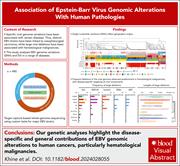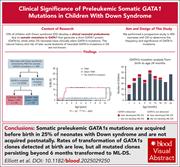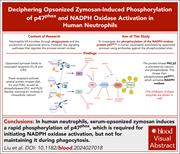Issue Archive
Table of Contents
BLOOD COMMENTARIES
PLENARY PAPER
Association of Epstein-Barr virus genomic alterations with human pathologies
Epstein-Barr virus (EBV) infects over 90% of humans and is associated with both hematological and epithelial malignancies. In this Plenary Paper, Khine and colleagues analyzed nearly 1,000 EBV genomic sequences from around the world and provide the most complete account to date of sequence variation and genome deletions of EBV, many of which relate to hematological diseases, including a new genetic lesion in EBNA3B that links to enhanced proliferation and immune escape in large B-cell lymphomas. This comprehensive analysis represents a remarkable resource for researchers working on EBV-associated diseases.
BLOOD SPOTLIGHT
New prognostic systems for multiple myeloma in the context of contemporary therapies
Clinical Trials & Observations
Recent advances in molecular diagnosis and novel therapies for multiple myeloma (MM) have prompted the need for new risk classifications of the disease. In this Blood Spotlight, Andrew Spencer draws on 2 important recent publications, 1 describing the combined International Myeloma Society and the International Myeloma Working Group recommendations for the definition of high-risk myeloma and the other a federated analysis of 24 randomized controlled trials that reveals robust prognostic associations, to offer an insightful perspective on the new prognostic model for MM. The author highlights how both studies converge on a redefinition of high-risk myeloma, particularly double-hit disease, within the context of contemporary therapies, offering valuable insights to clinical hematologists seeking to better understand this rapidly advancing field.
REVIEW ARTICLE
Deciphering the dynamics of histone acetylation and chromatin remodeling in multiple myeloma: a tale beyond the tails
Recent genomic and epigenomic discoveries have shown that the aberrations of histone modifications and chromatin remodeling are crucial to multiple myeloma (MM) pathogenesis, motivating researchers to develop epigenetic targets. This comprehensive review by Xiong et al provides a timely synthesis of current knowledge on epigenetic mechanisms underlying MM development, progression, and therapeutic resistance, connecting molecular insights to clinical challenges and opportunities.
CLINICAL TRIALS AND OBSERVATIONS
Clinical significance of preleukemic somatic GATA1 mutations in children with Down syndrome
Clinical Trials & Observations
Transient abnormal myelopoiesis (TAM) occurs in 10% of children with Down syndrome (DS) in the presence of somatic GATA1 mutations. Although usually self-limited, 20% of TAM transforms to myeloid leukemia associated with Down syndrome (ML-DS). Importantly, 20% of children with Down syndrome and GATA1 mutations do not develop overt TAM, a phenomenon known as “silent TAM.” Elliott and colleagues present a prospective longitudinal study of 450 newborn patients with DS providing a comprehensive overview of the natural history of TAM and silent TAM, finding that all mutated GATA1 clones persisting beyond 6 months of age transform to ML-DS, and that all but 1 patient who developed ML-DS had overt TAM at birth. These findings provide critical laboratory and clinical information for monitoring children with DS for hematological malignancies.
Silent TAM keeps quiet
Clinical Trials & Observations
LYMPHOID NEOPLASIA
Biallelic antigen escape is a mechanism of resistance to anti-CD38 antibodies in multiple myeloma
Although monoclonal antibodies targeting CD38 are a key part of the therapy landscape in multiple myeloma (MM), little is known about the mechanisms of resistance to these drugs. Diamond and colleagues demonstrate that biallelic disruption of CD38 is a rare (6%) but recurrent phenomenon in anti-CD38–exposed relapsed/refractory MM. Furthermore, the authors show that specific missense variants in CD38 cause changes in the protein that impede recognition by anti-CD38 therapies, providing a mechanistic link between heterozygous hits and functional escape.
Somatic IRF4 mutations and thymic tropism in primary mediastinal large B-cell lymphoma
Primary mediastinal large B-cell lymphoma (PMBCL) is an aggressive large B-cell lymphoma originating in the mediastinum, with unique genetic alterations and immune escape. Investigating a combination of large genomic datasets and functional experiments in cell lines and animal models, Rai and colleagues elucidate the functional significance of a recurrent alteration in the interferon regulatory factor 4 (IRF4) gene that leads to a cysteine-to-arginine substitution at amino acid position 99 (C99R) in PMBCL, particularly its impact on the interferon-gamma pathway and its contribution to thymic tropism via upregulation of ephrin type-B receptor 1 expression. This study contributes to our understanding of the functional effects of the IRF4-C99R mutation.
PHAGOCYTES, GRANULOCYTES, AND MYELOPOIESIS
Deciphering opsonized zymosan–induced phosphorylation of p47phox and NADPH oxidase activation in human neutrophils
Neutrophils use the NAD phosphate (NADPH) oxidase to produce reactive oxygen species that kill microbes within the phagosome. Assembly of the phagocyte NADPH is complex, and the role of the enzyme regulatory subunit p47phox phosphorylation has not been fully elucidated. Liu and colleagues demonstrate that p47phox phosphorylation is required for the initiation of NADPH oxidase activation but not for maintaining activation during phagocytosis, and that this process is mediated by opsonic membrane receptors Fc-gamma receptors and complement receptor 3. This study furthers our understanding of the critical role of NADPH in host defense.
PLATELETS AND THROMBOPOIESIS
Thrombocytopenia in myelofibrosis is characterized by inflammatory megakaryocytes with reduced G6B expression
Clinical Trials & Observations
The megakaryocyte (MK)-specific receptor G6b-B is required for normal production of platelets in the bone marrow, and reduced levels of G6b-B lead to abnormal megakaryocytes and myelofibrosis. Varricchio and colleagues investigate how the expression of G6b-B on hematopoietic progenitor cells correlates to platelet counts in patients with myelofibrosis (MF). The authors identify a positive feedback loop linking an increased expression of the secreted glycoprotein YKL-40 in patients with thrombocytopenia to impaired megakaryopoiesis, with loss of expression of G6b-B leading to a predominance of proinflammatory MK with high expression of profibrotic cytokines promoting MF.
LETTER TO BLOOD
Time to complete remission is an independent determinant of survival after intensive chemotherapy in AML
ERRATUM
-
Cover Image
Cover Image
![issue cover]()
Trichrome stain of the bone marrow from a patient with a loss-of-function mutation in
MPIG6B , which revealed marked fibrosis (MF 2-3+) with prominent type I collagen deposition in a background of marrow hypercellularity and osteosclerosis consistent with a myeloproliferative phenotype. See the article by Varricchio et al on page 1612. - PDF Icon Front MatterFront Matter
- PDF Icon Table of ContentsTable of Contents
- PDF Icon Editorial BoardEditorial Board
Advertisement intended for health care professionals
Email alerts
Advertisement intended for health care professionals











Epstein-Barr virus sequence mutations cause human diseases